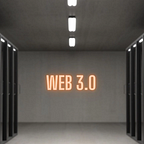What is Proof-of-Work
Proof of Work (PoW) is a consensus algorithm used in blockchain technology in order to validate and secure transactions.
My Web3 newsletter provides insights and actionable ideas about Web3, Blockchain, NFTs and Crypto straight to your inbox. If you are not already a subscriber, please follow me to join others who receive it directly in their inbox — it’s free!
Proof of Work (PoW) is a consensus algorithm used to validate and secure transactions and add new blocks to a blockchain network.
The first Proof of Work consensus algorithm was published in October 31st, 2008, by Satoshi Nakamoto, in the bitcoin whitepaper. The Proof of Work consensus algorithm is used in bitcoin and other blockchain networks to prevent double-spending and ensure the integrity of the blockchain.
One of the most important elements of Proof of Work blockchains is that they reward miners by issuing them newly minted cryptocurrency as a reward for helping secure the network.
The main elements of a Proof of Work consensus algorithm are:
- Miners: In a Proof of Work blockchain, for example, the bitcoin blockchain network, miners are computers running the bitcoin blockchain software. The miners compete to solve complex mathematical puzzles. The puzzles are usually known as the ‘hash rate’ signifying the ‘difficulty rate’.
- Transaction Validation: When a user initiates a transaction on a Proof of Work blockchain, the transaction is broadcast to all the nodes on the blockchain network. Miners will then proceed to collect all the transactions and organize them into a block, meaning that the transaction has been validated.
- Proof of Work: Once all the transactions have been organized into a block, miners must then find the correct value called a ‘nonce’. Finally, the correct ‘nonce’ is then ‘hashed’ containing the data in the correct block. This then results in the production of a new ‘hash’ that meets the correct criteria and then finally, a new block is added to the blockchain.
- Competition: Miners compete to find the correct ‘nonce’ by solving the puzzles. The process uses a significant amount of computational power and energy consumption. The competition between miners to be the first to solve the puzzle is what makes a Proof of Work blockchain secure. This is because of the resources needed and the difficulty in solving the puzzle in order to change past blocks or create fraudulent transactions.
- Consensus: The first miner to successfully solve the puzzle quickly broadcasts the solution to the blockchain network. Other nodes in the network will then verify that the broadcast solution is correct. If the broadcast solution is indeed correct, then a new block is added onto the blockchain. The first miner who broadcast the correct solution to the blockchain network is rewarded with newly minted cryptocurrency and transaction fees, for example on the bitcoin network, the miner would get freshly minted bitcoin as a reward.
- Difficulty Adjustment: Blockchains generally maintain a consistent block creation time, for example in the bitcoin blockchain network it is every 10 minutes. In order to achieve this, the Proof of Work blockchain network automatically adjusts the difficulty of the puzzle depending on the number of miners on the network. This ensures that when more miners join the network, the time to solve the puzzle remains relatively constant.
Proof of Work Advantages:
- Security: Proof of Work is highly secure. This is because of the computational power that is required to solve the puzzles. An attacker would need to control a majority of the network’s computational power (a 51% attack) in order to be able to manipulate the blockchain. For example, gaining 51% of the bitcoin network is extremely difficult and expensive.
- Decentralization: Proof of Work encourages and enables decentralization of the network. This is because anyone with the necessary computer hardware can download the software and become a miner, regardless of their location in the world.
- Proven Concept: Proof of Work has been successfully used in Bitcoin since January 3, 2009, when the bitcoin network came into existence, demonstrating its security and reliability.
Proof of Work, while being a well-established and secure consensus mechanism, has several disadvantages:
- Energy Consumption: Proof of Work requires miners to solve computationally intensive puzzles. This leads to very high consumption levels of electricity and computational resources. This energy consumption has raised environmental concerns and is often criticized for its carbon footprint.
- Scalability Challenges: Proof of Work faces scalability challenges, particularly when it comes to increasing transaction throughput. The time required to validate and add a new block to the blockchain can lead to slower transaction processing times during periods of high network activity. For example, during periods of high usage on the bitcoin network, transaction costs become extremely high leading to delays in processing transactions with low processing fees. This is the result of the ‘Blockchain Trilemma’.
- Long Confirmation Times: Proof of Work blockchains often require a certain number of block confirmations before considering a transaction as final. This can result in longer confirmation times compared to some alternative consensus mechanisms.
Since the original inception of Proof of Work blockchain in the bitcoin white paper titled “Bitcoin: A Peer-to-Peer Electronic Cash System” published in October 31, 2008. Proof of Work blockchain usage has experienced year on year growth.
If you enjoyed this breakdown, please share it with your friends. I work hard to create high-quality content, and every new subscriber helps.
About the Author
Kenneth Omoya is a visionary entrepreneur focusing on the intersection of startups and Web3 blockchain technology. He is the founder of a revolutionary Web3 blockchain company called Tripterium and is also a public speaker.
For more information, please visit:
Twitter | Tripterium Blockchain | Tripterium Capital | Kenneth Omoya
My Web3 newsletter provides insights and actionable ideas about Web3, Blockchain, NFTs and Crypto straight to your inbox. If you are not already a subscriber, please follow me to join others who receive it directly in their inbox — it’s free!
